#descendants antony
Text

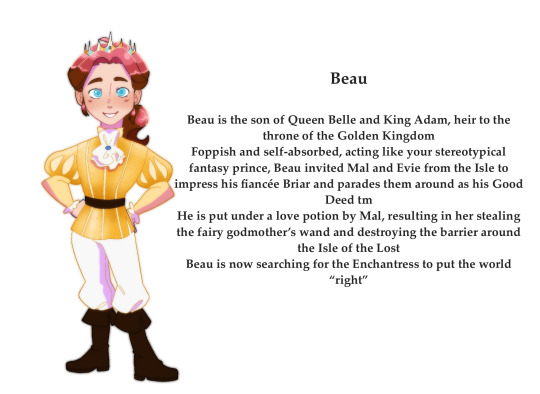



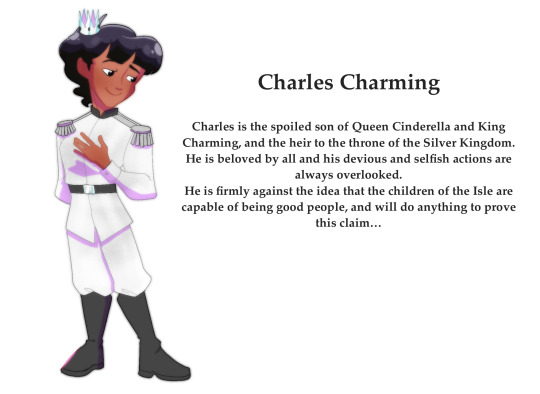

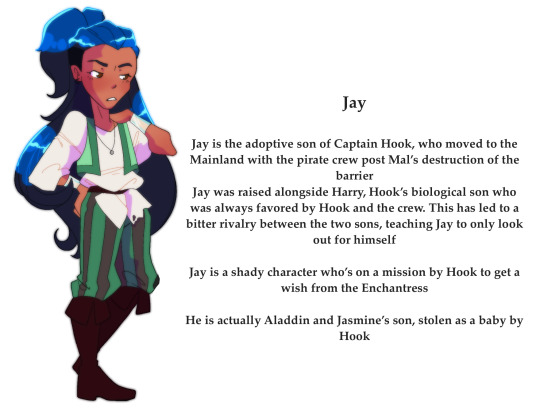
Descendants Redesign
That's all of them!
Yippee! Wahoo!!
All the relevant characters for the "movie" + Jay and Carlos who would be introduced in the follow up "series"
Hopefully these descriptions will give you a good idea of the plot of said movie when you put them all together, and I hope you guys get a good general idea of everyone and what their deals are
And wow I truly wrote fuck all for Charles. Sorry, lad, better luck next time
#descendants#disney descendants#disney descendants redesign#descendants mal#descendants ben#descendants evie#descendants antony#descendants audrey#descendants chad#descendants carlos#descendants jay#descendants redesign#descendants rewrite
306 notes
·
View notes
Text
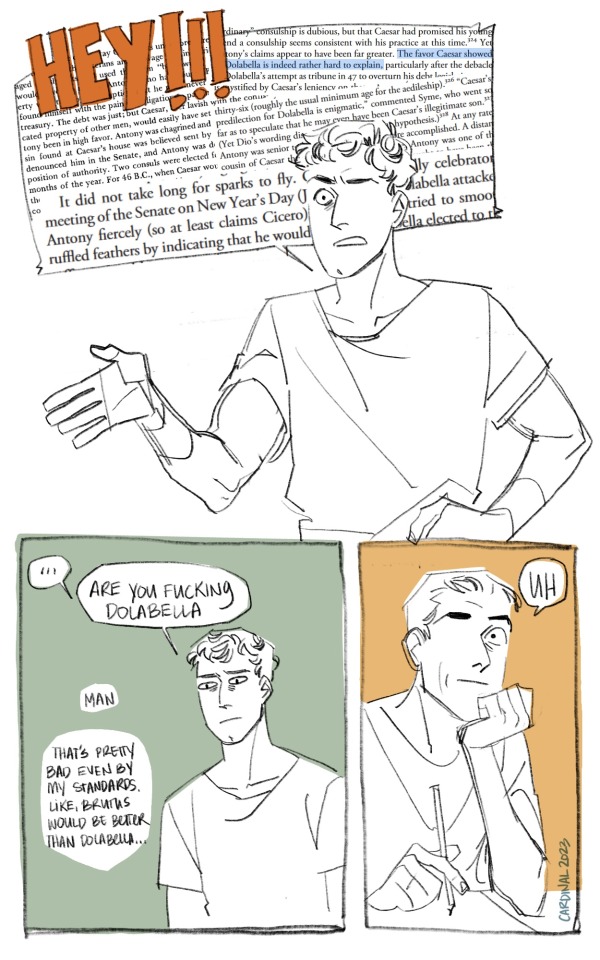
what's. what the fuck wrong with them. good grief. I need to put the three of them in a jar and study them

Mark Antony: A Biography, Eleanor Goltz Huzar

Julius Caesar and the Roman People, Robert Morstein-Marx


Mark Antony: A Biography, Eleanor Goltz Huzar
#if you follow me elsewhere you may have witnessed me descend into some kind of dolabella madness yesterday#which took an abrupt left turn when i got to the 11th philippic like YEAH ACTUALLY TEAR THE BITCH APART. GET HIM CASSIUS#justice for my man trebonius. cicero's letter to him got me feeling so emotional#this love triangle political clown show bullshit has a body count that makes the tris homines look moderate as a whole good GOD#gaius julius caesar#mark antony#roman republic tag#drawing tag#komiks tag
197 notes
·
View notes
Text
Me looking into the family tree of the Syrian branch of the Severan Dynasty:

#ancient rome#roman empire#mark antony#most of the severans in the syrian branch are possible descendants of cleopatra vii and mark antony#septimius severus is the exception#this would mean the Syrian branch of the Severan dynasty are possible deacendants of the 2 generals that rode with alexander the great#that being ptolemy i soter and seleucus i nicator#also possibly descended from apama
7 notes
·
View notes
Text
i’ve only done a bit of research in regards to nibenay/colovia, but from what i’ve found, i made megana the epitome of the nibenese on complete accident. a merchant’s daughter’s daughter, brought up wealthy and trained in the art of trade, not quite a battlemage as i’ve seen the nibenese described but pretty damn close - a mage who takes a more martial approach, using a sword and bits and pieces of armor (ie light boots and gauntlets, in game).
not to make everything about antony, but she and antony are also, again accidentally, a bit of an antithesis to each other? not in any major way, any way that really matters, but like… a personal growth sort of way.
megana begins as a rich girl from a rich family in a rich city, arrogant from her upbringing only to have that viewpoint crash down around her as she watches fire and death rain down around them, something neither she nor the imperial soldiers (a faction she surely grew up with, and is used to relying on) are able to deal with. her arrogance wanes and webs throughout her story, as she gains and loses power and witnesses personal and widespread tragedy.
antony begins as a criminal, a prisoner, imprisoned for the attempted murder of someone he truly thought was a “bad guy” (ie, a vampire). he’s arrogant despite his upbringing — arrogant because he survived — arrogant because he’s only ever done things for good, so surely he doesn’t count as a true criminal. this viewpoint is only strengthened when the emperor himself enters his cell, tells him the gods have told the emperor to trust him. his arrogance only truly begins to leave one time, and then the person responsible for that dies to save the entire world.
#oc: megana arterius#oc: antony#and megana is descended from the person who made antony gain a true conscience for once in his life#i almost called martin the *one person capable* but that’s not true imo. anyone could’ve helped antony gain empathy#if he only let himself be close to people. people who weren’t also criminals and murderers and justifying their sins to themselves and him#martin was just the first — and at that point the last — genuinely good person antony ever loved enough to think about his deeds#and how martin might react to knowing everything antony had done#i’m SO sorry megana i really didn’t mean for this to become a rant about antony AUGH#the relationship between the hok and martin is just so good and the dragonborn doesn’t inherently have a similar relationship#and i haven’t played her enuf to give her one
1 note
·
View note
Text

On this day in history, August 12th, two thousand and fifty three years ago, Cleopatra VII, the last active ruler of Ancient Egypt, committed suicide.
Eleven days previously, her husband Marc Antony had already done the same. The couple had been engaged in a civil war against Octavian, the great nephew of Julius Caesar who had been declared his legal heir. During the final battle in Alexandria, Antony suffered serious desertions among his troops and lost the fight. Upon his return, he falsely heard Cleopatra had killed herself and fell on his sword.
After Antony’s death, Octavian arrived in Egypt and effectively took Cleopatra and her children by Antony prisoner. She had sent her eldest son Caesarion, her only living child with Caesar, away for his own safety. She knew that Octavian planned for her to march in chains behind his chariot during his triumph parade, and would very likely have her killed afterwards. Rather than suffer such humiliations and indignity, she chose to take her own life.
Popular history and mythology leads us to believe that she was killed by inducing an asp to bite her, after having locked herself in her mausoleum with her two handmaidens. However, many modern scholars believe that she instead took a mixture of poisons, since the venom of an asp does not cause a quick or painless death. Octavian and his men found her too late to do anything, Cleopatra was already dead and one handmaiden, Iras, was nearly dead on the floor. The second, Charmian, was straightening the Queen’s diadem. According to legend, one of the men asked if this was well done of her mistress, and she shot back “Very well done, as befitting the descendant of so many noble Kings,“ before collapsing and dying herself.
Upon her death, Octavian honoured Cleopatra’s wish to be buried in her mausoleum at Antony’s side. He took her children with Antony, the twins Cleopatra Selene and Alexander Helios, along with their younger brother, Ptolemy Philadelphus, to Rome with him as prisoners of sorts. They were fated to march in his triumph parade in their mother’s place, the chains so heavy they could hardly walk. After this they were given to Octavian’s sister Octavia, who had been Antony’s third wife, to look after.
Cleopatra’s son with Caesar, Caesarion, was nominally sole ruler of Egypt after his mother’s death. Eleven days after her suicide, he was found after being lured back to Alxeandria under false pretenses of being allowed to rule in his mother’s place. Octavian ordered his murder, on advice that “Two Caesar were too many.”
With Cleopatra’s death, and Caesarion’s subsequent murder, the rule of the Ptolemaic Dynasty came to an end and Egypt became a mere Roman Province.
75 notes
·
View notes
Text

†Auroch (Bos primigenius)
Art credit: José Antoni
These giant prehistoric cattle lived in a variety of habitats during the ice age, from Europe, North Africa, and the Middle East, to India and East Asia. They were a significant animal to hundreds of cultures, featuring in European cave art, Babylonian murals, ancient Egyptian temples, and more. But over thousands of years they declined in region after region, and finally went extinct in 1627. But their effect on human history did not end there- aurochs were domesticated at least twice, and their descendants are modern cattle!
#markhors-menagerie#animal facts#animals#biology#fun facts#palaeontology#prehistoric animals#ungulates#even toed ungulates#ruminants#bovidae#Bovini#cattle#auroch
28 notes
·
View notes
Text
Do not be deceived by the greatness of the authority nor the abundance of possessions, nor the mass of bodyguards, nor the throng of courtiers. Men who have great power have great troubles. Those who have much, must spend largely. The crowd of bodyguards is gathered because of the crowd of conspirators, and the flatterers would be more glad to destroy than to save anyone. No sensible man would desire to become supreme ruler.
Attributed to Marcus Agrippa, via Cassius Dio, 52.10
There's an interesting exchange in Cassius Dio between Augustus, Agrippa and Maecenas, where they're trying to decide what to do with Rome's government now that Antony and Cleopatra have been defeated. Maecenas argues in favor of monarchy, but Agrippa says that's a terrible idea - both for Augustus personally, and for the future of their country. He thinks they should reinstate the republic.
Agrippa argues from principles and ideals - liberty, democracy, equal opportunity. And, as in the quote above, he doesn't think Augustus would be happy as a monarch. In other passages he says that ruling an empire is a pain in the ass, you'll be blamed for everything, and there's no way to make everybody happy.
But Augustus ultimately agrees with Maecenas, who argues more pragmatically that Rome's government is too damaged to go back to functioning as normal, and that stepping down from power would endanger Augustus' life. Agrippa accepts this decision, despite his personal qualms, because his loyalty to Augustus always comes first.
There's no way to know if such a conversation really happened. For all we know, Dio might have meant it an allegory to highlight the questions Augustus and his friends faced as they tried to rebuild Rome. But it tells us something about how Dio thought of these men: this Agrippa's aversion to permanent power mirrors his habit of downplaying his achievements and celebrity in other sources. His arguments are based on personal concern for Augustus' safety and happiness, too, also seen in other sources. Dio's Agrippa is a caring and principled man who probably would have embodied "the best of the old republic" in Dio's day.
See, Dio was writing during the Severan dynasty, by which point the power of the Senate was effectively dead, elections were long gone, and the principate Augustus, Maecenas and Agrippa had built was on the verge of descending into a 50-year civil war. Rome, by Dio's day, had endured several of the very tyrants Agrippa warns Augustus (and the reader) about.
That's not to say Dio's Maecenas was wrong - he's very clearly the more politically astute and pragmatic advisor here, and he does want what's best for Rome, too. And Dio doesn't blame Augustus for choosing to hold onto power instead of stepping down (and potentially putting his life at risk). I really like how this chapter portrays a morally murky situation with no clear answer, rather than the black-and-white framing in so much of our ancient sources.
29 notes
·
View notes
Text
SECOND BATTLE OF PHILIPPI, 23 RD OCT, 42 BC
Following the first battle both sides returned to their original camps to re-group. Brutus, taking over Cassius' camp, sought to stick to his original plan of holding station until the enemy was forced to withdraw through lack of provisions. Brutus did harass the enemy via night attacks on their position and even diverting a river to wash away part of their camp. Lacking supplies and having lost their back-up in the Adriatic, Antony and Octavian had to make their move before winter really set in and forced them to leave the field. Initially, Brutus stoically resisted the repeated taunting by the enemy to come out and face them but eventually, at least according to the ancient Roman historians, ill-discipline got the upper hand and Brutus' army took their own initiative and descended to the plain.

Antony had, meanwhile, also made some daring and decisive moves. First, he took full advantage of a small mound south of Brutus' camp which the Republican leader had left unguarded (and this despite the fact that Cassius had previously stationed a garrison on it). Building a palisade of whicker, four legions were now dangerously close to Brutus' position. At the same time Antony moved ten legions into the central marsh area and two more a little further east. Brutus responded by building a fortified camp facing each of these two blocks of enemy troops but if the battle lines were extended any further then Brutus would be isolated from his supplies and backed up against the mountains -an impossible position to defend. The Republican army, then, had little choice but to engage the enemy with a full-scale assault. The time for dilly-dallying was over.

The use of artillery weapons in the confines of such a tightly-packed battlefield was considered impractical and the opposing armies immediately clashed in fearsome hand-to-hand fighting. Initially, the Republicans did well against the enemy's left wing but Brutus, with fewer troops at his disposal, had stretched his lines thin to ward of an out-flanking manoeuvre. The consequence was Antony relentlessly pushed forward and smashed the enemy centre and, moving left, attacked the rear of Brutus' lines. The order of the Republican troops now completely broke down and chaos ensued. Meanwhile, Octavian had attacked the Republican camp while Antony used his cavalry to chase down Brutus and prevent his escape. The Republican leader had found refuge in the nearby mountains but when his four remaining legions moved to plea for clemency from Antony, Brutus took his own life. In total 14,000 soldiers surrendered and while some others managed to flee by ship to Thasos, the Republican cause was at an end and Julius Caesar's murder had been avenged. In the words of Ovid, "all the daring criminals who in defiance of the gods, defiled the high priest's head [Caesar], have fallen in merited death. Philippi is witness, and those whose scattered bones whiten its earth".
Whilst Antony was hailed as imperator by the victors and losers alike, Octavian, who had dealt more harshly with the defeated, was not so highly esteemed. As Plutarch stated in no uncertain terms, "[Octavian] did nothing worth relating, and all the success and victory were Antony's". The legions were again re-distributed with Antony taking eight to campaign against Parthia whilst Octavian, with three, returned to Italy. The battle, with its 40,000 fatalities and subsequent retaliations against Republican sympathizers, robbed Rome of some of its finest citizens and soldiers, and still the question of just who would rule Rome was not settled.
Sources: Si Sheppard, Philippi 42 BC.
Arthur Weigall, The Life & Times of Marc Antony
#mark antony#marc antony#marcus antonius#battle of philippi#octavian#caesar augustus#second triumvirate#marcus brutus#marcus junius brutus#julius caesar#gaius julius caesar#ancient rome#roman history#roman republic#roman empire#rome#history#otd#this day in history#pawel delag
18 notes
·
View notes
Text
Premade Heights
Since I’ve been playing around with the Stretchskeleton cheat on my own time, I decided I’d compile a list of which heights I use for each of the modern-day Veronaville premades.
I only use the following heights for family pictures or scene recreations. I do not use them for playthroughs or preview images, where I instead use the default height.
For the record, most of the height conversions were taken from this list by chickadeelee on LJ. I had to do some guessing with the taller sims (and by taller sims, I mean Caliban).
Capp Family
Albany -- 5′9″ -- 1.0
Caliban -- 6′8″ -- 1.14
Consort -- 6′1″ -- 1.06
Contessa -- 5′4″ -- 0.93
Cordelia -- 5′2″ -- 0.9
Cornwall -- 6′4″ -- 1.1
Goneril -- 5′6″ -- 0.955
Hermia -- 5′3″ (final height = 5′4″) -- 0.915 (final = 0.93)
Juliette -- 5′5″ -- 0.94
Kent -- 6′0″ -- 1.045
Miranda -- 5′4″ (final height = 5′6″) -- 0.93 (final = 0.955)
Regan -- 5′11″ -- 1.03
Tybalt -- 5′7″ -- 0.97
Monty Family
Antonio -- 5′10″ -- 1.015
Bianca -- 5′5″ -- 0.94
Claudio -- 5′8″ -- 0.985
Hero -- 5′5″ -- 0.94
Isabella -- 5′6″ -- 0.955
Mercutio -- 6′0″ (final height = 6′1″) -- 1.045 (final = 1.06)
Olivia -- 5′7″ -- 0.97
Patrizio -- 6′2″ -- 1.07
Romeo -- 5′7″ (final height = 5′8″) -- 0.97 (final = 0.985)
Summerdream Family
Oberon -- 6′3″ -- 1.085
Puck -- 5′9″ (final height = 6′0″) -- 1.0 (final = 1.045)
Titania -- 5′10″ -- 1.015
As you can see, some of the teens have “final” heights listed while others do not. This is because not all of the teens have hit the point in their lifestage when they stop growing. For females, that would be during their midteens (10 -- 6 days until adulthood); whereas males stop growing during their late teens (5 days -- end). Juliette and Tybalt are the only teens who meet those specifications when you first play the neighborhood, so that’s why I didn’t specify their “final” height like I did their contemporaries.
Mercutio (6 days until adulthood), Romeo (8 days until adulthood), and Puck (10 days until adulthood) are in their midteens when the game starts. Hermia (12 days until adulthood) and Miranda (13 days until adulthood) are in their early teens.
The kids and toddlers don’t really have set heights, but here are the following heights I use for each age group.
Toddlers
Early Toddlerhood (4 days until childhood) -- 0.95
Mid Toddlerhood (3 days until childhood)-- 1.0
Late Toddlerhood (2--1 days until childhood) -- 1.2
Ariel has four days to go until childhood when the game starts, so she would use the height assigned to early toddlerhood sims.
Children
Early Childhood (8 -- 6 days until adolescence) -- 0.93
Mid Childhood (5 -- 4 days until adolescence) -- 1.0
Late Childhood (3 days -- end until adolescence) -- 1.2
Beatrice, Benedick, and Hal are all four days away from adolescence when the game starts, whereas Bottom is five days away. As such, those four sims would be assigned the default child height. Desdemona is six days away from adolescence, so she’d be assigned the early childhood height when the game starts.
As for the ancestors, I haven’t decided on all of their heights yet. The ones based on historical figures (Contessa’s and Albany’s ancestors) use the same heights provided there is a surviving record of it. The rest of them have heights that I picked out either because they worked with their descendants’ heights, or because I pictured the sim being that height.
As of right now, I have recorded the following
Cleopatra Capp was 5′11″
Antony Capp was 6′0″
Julius Caesar was 5′7″
Octavius Capp was 5′9″
William Norman was 5′10″
Mathilde Norman was 5′0″
Richard Norman was 5′8″ (I think this is is somewhat historically accurate, but I may be wrong)
All of these heights are ones that I found for their historical counterparts. I couldn’t find a height for the following sims, but here’s what I came up with on my own:
I have Scribonia Capp listed as being 5′1″ (I picture her being on the shorter side, even though her parents were both above average height).
I couldn’t find any specific heights for Henry and Eleanor Anjou, but I read that Henry II of England was medium height, whereas Eleanor of Aquitaine was tall.
And here’s some ancestral premades based on either figures from mythology or one of Shakespeare’s plays:
Andromache Thebe is listed as 5′6″
Hector Thebe is listed as 6′0″
Vincentio Pantalone is listed as 5′9″
Francisca Pantalone is listed as 5′3″
Hecuba Albion is listed as 5′2″
Priam Albion is listed as 6′0″
TL; DR: Here’s a list of Veronaville’s teens, adults, and elders in descending order of height:
Caliban (6′8″ or 1.14)
Cornwall (6′4″ or 1.1)
Oberon (6′3″ or 1.085)
Patrizio (6′2″ or 1.07)
Consort (6′1″ or 1.06)
Mercutio (6′0″ or 1.045)
Kent (6′0″ or 1.045)
Regan (5′11″ or 1.03)
Antonio (5′10″ or 1.015)
Titania (5′10″ or 1.015)
Puck (5′9″ or 1.0)
Albany (5′9″ or 1.0)
Claudio (5′8″ or 0.985)
Romeo (5′7″ or 0.97)
Olivia (5′7″ or 0.97)
Tybalt (5′7″ or 0.97)
Isabella (5′6 or 0.955)
Goneril (5′6 or 0.955)
Bianca (5′5″ or 0.94)
Hero (5′5″ or 0.94)
Juliette (5′5″ or 0.94)
Miranda (5′4″ or 0.93)
Contessa (5′4″ or 0.93)
Hermia (5′3″ or 0.915)
Cordelia (5′2″ or 0.9)
#veronaville#sims 2#capp family#monty family#summerdream family#sims#too many sims to tag#headcanon humpday#veronaville headcanons
16 notes
·
View notes
Text
A conference this week marking 25 years since the adoption of international standards for restituting Nazi-looted artwork presented a new set of best practices on the issue that have been adopted by more than 20 countries.
The best practices, set out by the World Jewish Restitution Organization, or WJRO, and the Conference on Jewish Material Claims Against Germany, aim to “enhance” the 1998 Washington Principles on Nazi-Confiscated Art.
The Washington Principles are a non-binding set of 11 guidelines on how to approach artwork that was stolen from Jews by the Nazis. They were adopted in 1998 by 44 countries and are credited with establishing norms around how countries should work to restitute the stolen pieces. Now, 21 other countries have signed on to the new standards unveiled this week.
In recent years, some of those efforts have paid off, as a swath of Nazi-looted art has been returned to the heirs of the original owners around the globe. But many of those restitutions occurred following court battles, which art provenance researchers say is an inefficient method of restitution that can take years. The issue of Nazi looting also drew attention last year when Christie’s auctioned off much of a large collection jewelry that was linked to Nazi plunder.
But along with the best practices document, the WJRO and Claims Conference published a report detailing the status of arts and cultural property restitution across 47 countries. That report found that while seven countries have made major progress in art and cultural property restitution, 24 countries have made minimal to no progress.
The report also found that relatively significant progress has been made with items held in public collections and museums, but not as much when it comes to items formerly owned by individuals or communities that are now in private hands.
The updated best practices document, presented at a March 5 conference hosted by the WJRO and U.S. State Department, provides a more explicit manual for how countries can implement the original principles without going through the courts.
“The Best Practices were drafted with the awareness that there are differing legal systems and that states act within the context of their own laws,” Stuart Eizenstat, the U.S. Secretary of State’s special advisor on Holocaust issues and a central figure in drafting the original principles, said in a statement. “While they are legally non-binding, they are morally important and, as with the Washington Principles, will advance art restitution.”
The new best practices document, which was introduced by Secretary of State Antony Blinken in a video address, specifies that works sold under duress during the Holocaust are considered looted or confiscated by the Nazis. It also says governments should encourage provenance researchers to make their findings public, and that institutions should provide access to any relevant archives or documents that could help in provenance work.
The best practices also say governments should create independent expert bodies to adjudicate these cases and avoid litigation, something the Netherlands has done in recent years. And the document says countries should make it easier legally for works that are hanging in state-owned and private collections to be returned to their original owners or their descendants.
“Of the millions of works of art and cultural property stolen by the Nazis, countless objects still have not been returned to their owners,” Blinken said in his remarks. “Today, too many governments, museums, dealers, galleries and individuals still resist restitution efforts, while heirs confront staggering legal and financial barriers as they go up against opponents whose resources vastly outmatch their own.”
Provenance researchers and scholars in the field of stolen art spoke about the progress they have seen over the past 25 years, and also proposed alternative approaches to restitution that address many claims at once, as opposed to case-by-case lawsuits to restore stolen works.
“I believe that the next 25 years we will be slowly moving away from individualists’ private property paradigm envisioned in the Washington Principles,” said Leora Bilsky, legal scholar and professor at Tel Aviv University. “If we keep on dealing only with a one-by-one property, honestly, we are not going to get to a solution and the time is running and it is important to think of more structural solutions.”
9 notes
·
View notes
Text
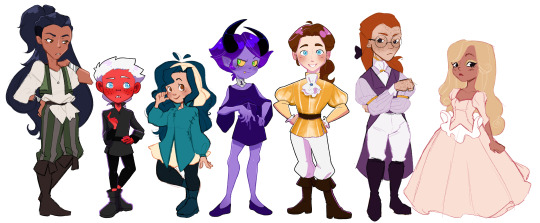
Back with more Descendants redesigns
Namely two news ones
Augustus and Briar
Augustus, canon name Anthony, is the son of Anastasia and the Baker. He currently works as Beau's squire/tutor/government assigned best friend.
As the son of a redeemed villain, he is considered an outcast among his peers, and it appears everyone is expecting him to turn out ultimately evil. He takes his job very seriously and wants to prove both himself and his mother as good people.
He befriends Evie during the "movie" and helps her get ready for an upcoming ball. He is well aware that it is going to be a test for her, and that everyone is expecting her to fail and label irredeemably evil, so does his utmost to train her to be ladylike.
Briar, canon name Audrey, is the daughter of Aurora and Phillip. She is the princess of her parent's kingdom and the fiancée of Prince Beau, with the goal of their marriage being the union of their two kingdoms.
She is rather vain and self-centered, unaware of problems around her. While not completely malicious, she is in need of some humbling.
She feels pressured to be an ideal fairy-tale princess, fit for her prince, but she finds this more and more difficult each day.
She is in love with Beau, and is beyond hurt when he suddenly publicly breaks up their engagement and professes his love for Mal.
After the love spell is broken, Beau doesn't go to see Briar, and it appears he never cared for her at all.
And she's angry.
Tried doing a design for Jane too but maaaan was it UGLY. Like really not good, needs a lot of work lol.
#descendants#descendants carlos#descendants evie#descendants mal#disney descendants#disney descendants redesign#descendants jay#descendants ben#descendants audrey#descendants antony
186 notes
·
View notes
Text

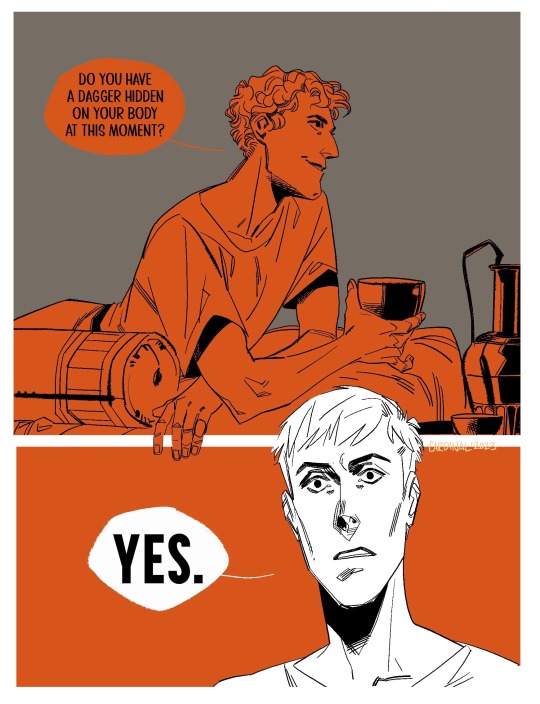

So they came to an agreement on the terms that had been voted, but those on the Capitol would not come down till they had secured the son of Lepidus and the son of Antony as hostages; then Brutus descended to Lepidus, to whom he was related, and Cassius to Antony, under promise of safety. And while they were dining together they naturally, at such a juncture, discussed a variety of topics and Antony asked Cassius: "Have you perchance a dagger under your arm even now?" To which he answered: "Yes, and a big one, if you too should desire to make yourself tyrant."
Cassius Dio 44.34
antony: is that a dagger or are you just happy to see me
cassius: why don't you fuck around and find out
OKAY more serious commentary: cassius and lentulus spinther had a coin with the image of libertas on one side minted in ~42 BCE! so the figure behind cassius in the last page is libertas. she has the pileus in one hand, but instead of a rod, she's holding a dagger.

there's a pomegranate in one of the table panels! I feel like antony would enjoy them. they feel kind of flirty, kind of threatening, a great way to send some kind of subtextual message to someone you low key have a narrative foils dynamic with
#it is a CRIME that brutus somehow ended up as the symbol for tyrannicide when my man cassius is RIGHT THERE#saying it with his whole chest!!!!!!!#gaius cassius longinus#mark antony#antony enjoyers this is for you. i spent a lot of time inking his hair#komiks tag#drawing tag#roman republic tag
712 notes
·
View notes
Text
By: Richard Dawkins
Published: Nov 13, 2023
“I say, Jarvis, cluster round.”
“Sir?”
“Close on me – if that’s the right expression?”
“A military phrase, sir, employed by officers requiring the presence of their subordinates.”
“Right, Jarvis. Lend me your ears.”
“Equally appropriate, sir. Mark Antony . . .”
“Never mind Mark Antony, Jarvis. This is important.”
“Very good sir.”
“As you know, Jarvis, when it comes to regions north of the collar stud, B Woofter is not rated highly in the form book. Nevertheless, I do have one great scholastic triumph to my credit. And I bet you don’t know what that was?”
“You have frequently adverted to it sir. You won the prize for Scripture Knowledge at your preparatory academy.”
“Yes, Jarvis, I did, to the ill-concealed surprise of the Rev Aubrey Upcock, proprietor and chief screw at that infamous hell-hole. And ever since then, although not much of a lad for Matins or Evensong, I’ve always had a soft spot for Holy Writ as we experts call it. And now we come to the nub. Orcrux, Jarvis?”
“Very appropriate sir, or ‘nitty gritty’ is these days often heard.”
“The point is, Jarvis, as an aficionado, I have long been especially fond of the book of Genesis. God made the world in six days, am I right, Jarvis?”
“Well sir . . .”
“Beginning with light, God moved swiftly through the gears, making plants and things that creep, scaly things with fins, our feathered friends tootling through the trees, furry brothers and sisters in the undergrowth and finally, rounding into the straight, he created chaps like us, before taking to his hammock for a well-earned siesta on the seventh day. Am I right, Jarvis?”
“Yes sir, if I may say so, a colourfully mixed summary of one of our great origin myths.”
“But now, Jarvis, mark the sequel. A fellow at the Dregs Christmas party was bending my ear last night over the snort that refreshes. Seems there’s a cove called Darwin who says Genesis is all a lot of rot. God’s been oversold on the campus. He didn’t make everything after all. There’s something called evaluation . . .”
“Evolution sir. The theory advanced by Charles Darwin in his great book of 1859, On the Origin of Species.”
“That’s the baby, Jarvis. Evolution. Would you credit it, this Darwin bozo wants me to believe my great great grandfather was some kind of hirsute banana-stuffer, scratching himself with his toes and swinging through the treetops. Now, Jarvis, answer me this. If we’re descended from chimpanzees, why are there chimpanzees still among those present and correct? I saw one only last month at the zoo. Why haven’t they all turned into members of the Dregs Club (or the Athenaeum according to taste)? Try that on your pianola, Jarvis.”
“If I might take the liberty, sir, you appear to be labouring under a misunderstanding. Mr Darwin does not say that we are descended from chimpanzees. Chimpanzees and we are descended from a shared ancestor. Chimpanzees are modern apes, which have been evolving since the time of the shared ancestor, just as we have.”
“Hm, well I think I get your drift, Jarvis. Just as my pestilential cousin Thomas and I are both descended from the same grandfather. But neither of us looks any more like the old reprobate than the other, and neither of us has his side-whiskers.”
“Precisely sir.”
“But hang on, Jarvis. We old lags of the Scripture Knowledge handicap don’t give up that easily. My old man’s guvnor may have been a hairy old gargoyle, but he wasn’t what you’d call a chimpanzee. I distinctly remember. Far from dragging his knuckles over the ground, he carried himself with an upright, military bearing (at least until his later years, and when the port had gone round a few times). And the family portraits in the old ancestral home, Jarvis. We Woofters did our bit at Agincourt, and there were no apes on the strength during that “God for Harry, England and St George” carry-on.”
“I think, sir, you underestimate the time spans involved. Only a few centuries have passed since Agincourt. Our shared ancestor with chimpanzees lived more than five million years ago. If I might venture upon a flight of fancy sir?”
“Certainly you might, Jarvis. Venture away, with the young master’s blessing”
“Suppose you walk back in time one mile, sir, to reach the Battle of Agincourt . . .”
“Sort of like walking from here to the Dregs, Jarvis?”
“Yes sir. On the same scale, to walk back to the ancestor we share with chimpanzees, you’d have to walk all the way from London to Australia.”
“Goodness, Jarvis, all the way to the land of cobbers with corks dangling from their lids. No wonder there are no apes among the family portraits, no low-browed chest-thumpers to be seen once-more-unto-the-breaching at Agincourt.”
“Indeed sir, and to go back to our shared ancestor with fish . . .”
“Wait a minute, Jarvis, hold it there. Are you now telling me I’m descended from something that would feel at home on a slab?”
“We share ancestors with modern fish, sir, which would certainly have been called fish if we could see them. You could safely say that we are descended from fish, sir.”
“Jarvis, sometimes you go too far. Although, when I think of Gussie Hake-Wortle . . .”
“I would not have ventured to make the comparison myself sir. But if I might pursue my fanciful perambulation back through time, sir? To reach the ancestor that we share with our piscine cousins . . .”
“Let me guess, Jarvis, you’d have to walk right round the whole bally globe and come back to where you started and surprise yourself from behind?”
“A considerable underestimate sir. You’d have to walk to the moon and back, and then set off and do the whole journey again sir.”
“Jarvis, this is too much to spring on a lad with a morning head. Go and mix me one of those pick-me-ups of yours before I can take any more.”
“I have one in readiness sir, prepared when I perceived the lateness of the hour of your return from your club last night.”
“Attaboy, Jarvis. But wait, here’s another thing. This Darwin bird says it all happened by chance. Like spinning the big wheel at Le Touquet. Or like when Bufty Snodgrass scored a hole in one and stood drinks for the whole club for a week.”
“No sir that is incorrect. Natural selection is not a matter of chance. Mutation is a chance process. Natural selection is not.”
“Take a run-up and bowl that one by me again, Jarvis, if you wouldn’t mind. And this time make it your slower ball, with no spin. What is mutation?”
“I beg your pardon sir, I presumed too much. From the Latin mutatio, feminine, ‘a change’, a mutation is a mistake in the copying of a gene.”
“Like a misprint in a book, Jarvis?”
“Yes sir, and, like a misprint in a book, a mutation is not likely to lead to improvement. Just occasionally, however, it does, and then it is more likely to survive and be passed on in consequence. That would be natural selection. Mutation, sir, is random in that it has no bias towards improvement. Selection, by contrast, is automatically biased towards improvement, where improvement means ability to survive. One could almost coin a phrase, sir, and say ‘Mutation proposes, selection disposes.’
“Rather neat that, Jarvis. Your own?”
“No sir, the pleasantry is an anonymous parody of Thomas à Kempis.”
“So, Jarvis, let me see if I’ve got a firm grip on the trouser seat of this problem. We see something that looks like a piece of natty design, like an eye or a heart, and we wonder how it bally well got here.”
“Yes sir.”
“It can’t have got here by pure chance because that would be like Bufty’s hole in one, when we had drinks all round for a week.”
“In some respects it would be even more improbable than the Honourable Mr Snodgrass’s alcoholically celebrated feat with the driver, sir. For all the parts of a human body to come together by sheer chance would be about as improbable as a hole in one if Mr Snodgrass were blindfolded and spun around, so that he had no idea of the whereabouts of the ball on the tee, nor of the direction of the green. Were he to be permitted a single stroke with a wood, sir, his chance of scoring a hole in one would be about as great as the chance of a human body spontaneously coming together if all its parts were shuffled at random.”
“What if Bufty had had a few drinks beforehand, Jarvis? Which, by the way, is pretty likely.”
“The contingency of a hole in one is sufficiently remote, sir, and the calculation sufficiently approximate, that we may neglect the possible effects of alcoholic stimulants. The angle subtended at the tee by the hole . . .”
“That’ll do, Jarvis, remember I have a headache. What I clearly see through the fog is that random chance is a non-starter, a washout, scratched at the off. So how do we get complex things that work, like human bodies?”
“To answer that question, sir, was Mr Darwin’s great achievement. Evolution happens gradually and over a very long time. Each generation is imperceptibly different from the previous one, and the degree of improbability required in any one generation is not prohibitive. But after a sufficiently large number of millions of generations, the end product can be very improbable indeed, and can look very much as though it was designed.”
“But it only looks like the work of some slide-rule toting whizz with a drawing board and a row of biros in his top pocket?”
“Yes sir, the illusion of design results from the accumulation of a large number of small improvements in the same direction, each one small enough to result from a single mutation, but the whole cumulative sequence is prolonged enough to culminate in an end result that could not have come about in a single chance event. The metaphor has been advanced of a slow climb up the gentle slopes of what has somewhat over-dramatically been called ‘Mount Improbable’, sir.”
“Jarvis, that’s a doozra of an idea, and I think I’m beginning to get my eye in for it. But I wasn’t too far wrong, was I, when I called it ‘evaluation’ instead of evolution?”
“No sir. The process somewhat resembles the breeding of racehorses. The fastest horses are evaluated by breeders and the best ones are chosen as progenitors of future generations. Mr Darwin realised that in nature the same principle works without the need for any breeder to do the evaluating. The individuals that run fastest are automatically less likely to be caught by lions.”
“Or tigers, Jarvis. Tigers are very fast, Inky Brahmapur was telling me at the Dregs only last week.”
“Yes sir, tigers too. I can well imagine that his Highness would have had ample opportunity to observe their speed from the back of his elephant. The nub, or crux, is that the fastest individual horses survive to breed and pass on the genes that made them fast, because they are less likely to be eaten by large predators.
“By Jove, Jarvis, that makes a lot of sense. And I suppose the fastest tigers also get to breed because they are the first ones to grab their medium rare with all the trimmings, and so survive to have little tigers that also grow up to be fast.”
“Yes sir.”
“But this is amazing, Jarvis. This really prangs the triple twenty. And the same thing works not just for horses and tigers but for everything else?”
“Precisely sir.”
“But Jarvis, wait a moment. I can see that this bowls Genesis middle stump. But where does it leave God? It sounds from what this Darwin bimbo says, that there’s not a lot left for God to do. I mean to say, Jarvis, I know what it’s like to be underemployed, and underemployed is what God, if you get my drift, would seem to be.”
“Very true sir.”
“So, well, dash it, I mean to say, Jarvis, in that case why do we even believe in God at all?”
“Why indeed sir?”
“Jarvis, this is astounding. Incredulous.”
“Incredible sir.”
“Yes, incredible, Jarvis. I shall see the world through new eyes, no longer through a glass darkly as we biblical scholars say. Don’t bother with that pick-me-up, Jarvis. I find I no longer need it. I feel sort of liberated. Instead, bring me my hat, my stick, and the binoculars Aunt Daphne gave me last Goodwood. I’m going out into the park to admire the trees, the butterflies, the birds and the squirrels, and marvel at everything you have told me. You don’t mind if I do a spot of marvelling at everything you’ve told me, Jarvis?”
“No indeed sir. Marvelling is very much in the proper vein, and other gentlemen have told me that they experience the same sense of liberation on first comprehending such matters. If I might make a further suggestion sir?”
“Suggest away, Jarvis, suggest away, we are always ready to hear suggestions from you.”
“Well sir, if you would care to follow the matter further, I have a small volume here, which you might care to peruse.”
“Doesn’t look very small to me, Jarvis, but anyway, what is it called?”
“It is called The Greatest Show on Earth, sir, and it is by . . .”
“It doesn’t matter who it’s by, Jarvis, any friend of yours is a friend of mine. Heave it over and I’ll have a look when I return. Now, the binoculars, the stick and the gents’ bespoke headwear if you please. I have some intensive marvelling to do.”
==
Note: "The Greatest Show on Earth: The Evidence for Evolution" is by Richard Dawkins. It's a little self-referential, tongue-in-cheek joke.
#Richard Dawkins#Charles Darwin#evolution#common ancestry#natural selection#science#common ancestor#mutation#religion is a mental illness
10 notes
·
View notes
Text


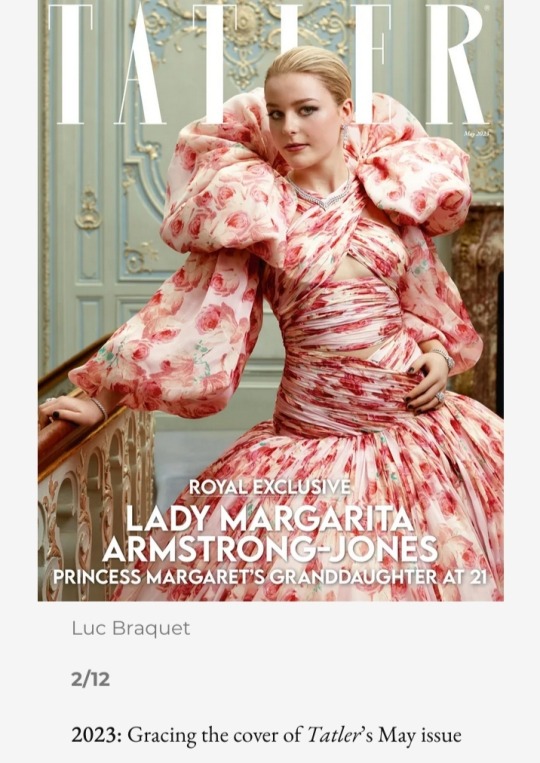
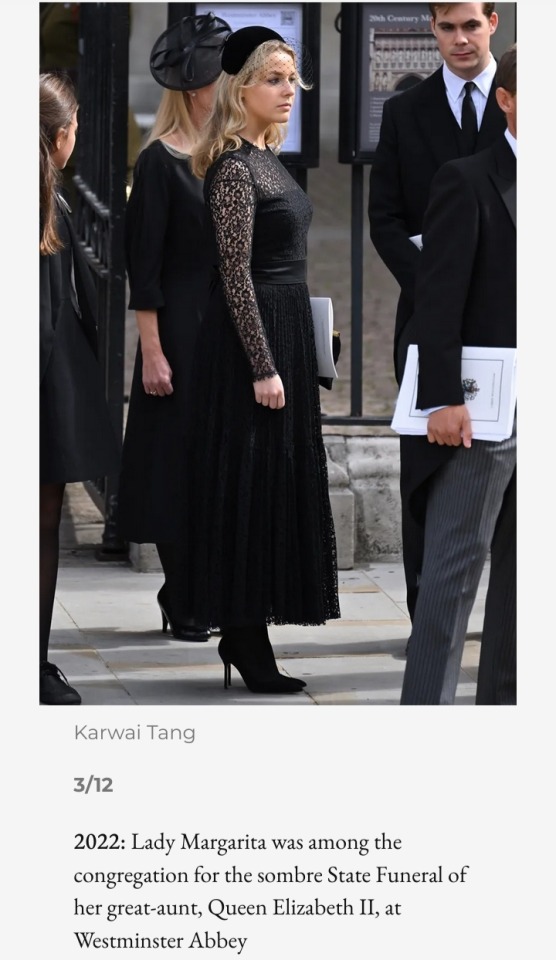


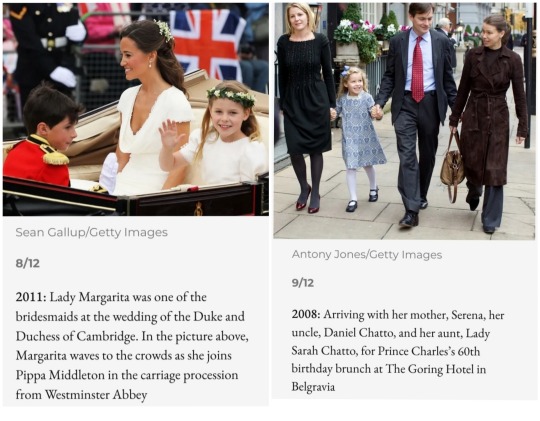



xxx
Lady Margarita Elizabeth Rose Alleyne Armstrong-Jones (born 14 May 2002) is an English socialite, jewellery designer, and a member of the British royal family.
She was born The Honourable Margarita Armstrong-Jones on 14 May 2002 at Portland Hospital in London.
She is the daughter of David Armstrong-Jones, 2nd Earl of Snowdon, who was styled as Viscount Linley at the time of her birth, and The Honourable Serena Stanhope.
On her father's side, she is the granddaughter of Princess Margaret, Countess of Snowdon, and Antony Armstrong-Jones, 1st Earl of Snowdon, and a great-granddaughter of George VI.
On her mother's side, she is the granddaughter of Charles Stanhope, 12th Earl of Harrington, and a descendant of Charles II.
She was baptized Margarita Elizabeth Rose Alleyne and was named after her grandmother and great-grandmother, Queen Elizabeth The Queen Mother.
She served as a bridesmaid at the wedding of Prince William and Catherine Middleton in 2011.
She has accompanied the British monarch and members of the royal family to public events. As of 2023, she is twenty-sixth in the line of succession.
Lady Margarita is a jewellery designer and the creator of the bespoke jewellery label Matita.
#Lady Margarita Elizabeth Rose Alleyne Armstrong-Jones#Princess Margaret#David Armstrong-Jones#Serena Stanhope#Queen Elizabeth II#Prince William#Matita#British Royal Family
21 notes
·
View notes
Photo

On this day in history, August 12th, two thousand and fifty two years ago, Cleopatra VII, the last active ruler of Ancient Egypt, committed suicide.
Eleven days previously, her husband Marc Antony had already done the same. The couple had been engaged in a civil war against Octavian, the great nephew of Julius Caesar who had been declared his legal heir. During the final battle in Alexandria, Antony suffered serious desertions among his troops and lost the fight. Upon his return, he falsely heard Cleopatra had killed herself and fell on his sword.
After Antony’s death, Octavian arrived in Egypt and effectively took Cleopatra and her children by Antony prisoner. She had sent her eldest son Caesarion, her only living child with Caesar, away for his own safety. She knew that Octavian planned for her to march in chains behind his chariot during his triumph parade, and would very likely have her killed afterwards. Rather than suffer such humiliations and indignity, she chose to take her own life.
Popular history and mythology leads us to believe that she was killed by inducing an asp to bite her, after having locked herself in her mausoleum with her two handmaidens. However, many modern scholars believe that she instead took a mixture of poisons, since the venom of an asp does not cause a quick or painless death. Octavian and his men found her too late to do anything, Cleopatra was already dead and one handmaiden, Iras, was nearly dead on the floor. The second, Charmian, was straightening the Queen’s diadem. According to legend, one of the men asked if this was well done of her mistress, and she shot back “Very well done, as befitting the descendant of so many noble Kings,“ before collapsing and dying herself.
Upon her death, Octavian honoured Cleopatra’s wish to be buried in her mausoleum at Antony’s side. He took her children with Antony, the twins Cleopatra Selene and Alexander Helios, along with their younger brother, Ptolemy Philadelphus, to Rome with him as prisoners of sorts. They were fated to march in his triumph parade in their mother’s place, the chains so heavy they could hardly walk. After this they were given to Octavian’s sister Octavia, who had been Antony’s third wife, to look after.
Cleopatra’s son with Caesar, Caesarion, was nominally sole ruler of Egypt after his mother’s death. Eleven days after her suicide, he was found after being lured back to Alxeandria under false pretenses of being allowed to rule in his mother’s place. Octavian ordered his murder, on advice that “Two Caesar were too many.”
With Cleopatra’s death, and Caesarion’s subsequent murder, the rule of the Ptolemaic Dynasty came to an end and Egypt became a mere Roman Province.
102 notes
·
View notes
Text
Surprise! We're talking about
Cleopatra.
Or more specifically, the way she's been painted over the centuries.

Unfortunately, not many historical references of Cleopatra's face have survived, and even the Romans didn't clearly know what she looked like- but she was always orally described as someone who wasn't captivating at first glance, but would draw people in with her voice and words. So from this, we can conclude that while she was probably decent-looking, it was her charisma which drew people in.
The only other thing we can use to determine Cleopatra's appearance is her genealogy- she descended from one of Alexander the Great's generals and was part of a family line with Targaryen levels of inbreeding. So there's a real chance that she resembled the Greeks and Macedonians more than the native Egyptians, ergo paler skin and darker hair.
European painters, of course, disregarded this entirely and freely drew her on a spectrum from beguiling Greek Aphrodite to Elizabethan era blonde, complete with the giant dresses they had back then.


The topics, however, were very repetitive- either Cleopatra appearing in front of Caesar, Cleopatra appearing in front of Marc Antony on a boat, Cleopatra doing the pearl-in-vinegar trick at a feast, or Cleopatra killing herself via snakebite. (That last one is particularly popular.)


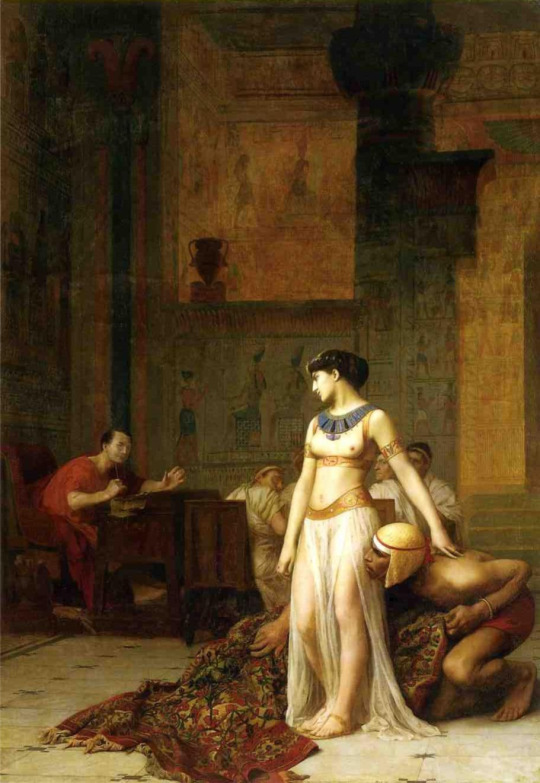

(Also she was almost always depicted in a seductive manner, even while a snake was about to bite her. Just very femme-fataley, not my cup of tea personally.)
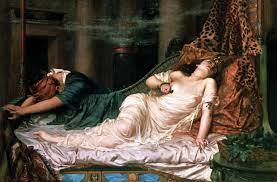
Like, just look at this image. It feels a tad bit more erotic than it needs to be, and that's a very consistent artistic choice that just weirds me out.
I feel like in all these paintings and topics, we're missing many important parts of Cleopatra's life- what was her daily life like? How did she rule, what were her familial relationships like? With that in mind, here's some of my favourite paintings-
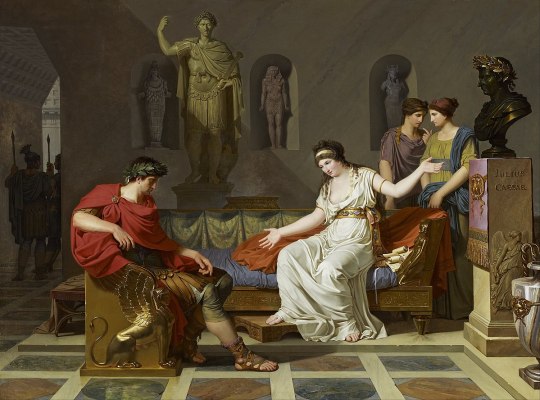


These just show her doing presumably mundane activities- testing out poisons, attending Caesar's funeral (obviously fake, but still), meeting with Octavian to negotiate a deal. I think these show a glimpse into what the life of such a powerful leader would be like, and we really need more of those. The "Cleopatra femme fatale" market is overly saturated.
Anyways, that's all for today! If you have any comments or critiques, feel free to fire away in the comments or reblog tags, it'll mean a lot to me.
20 notes
·
View notes